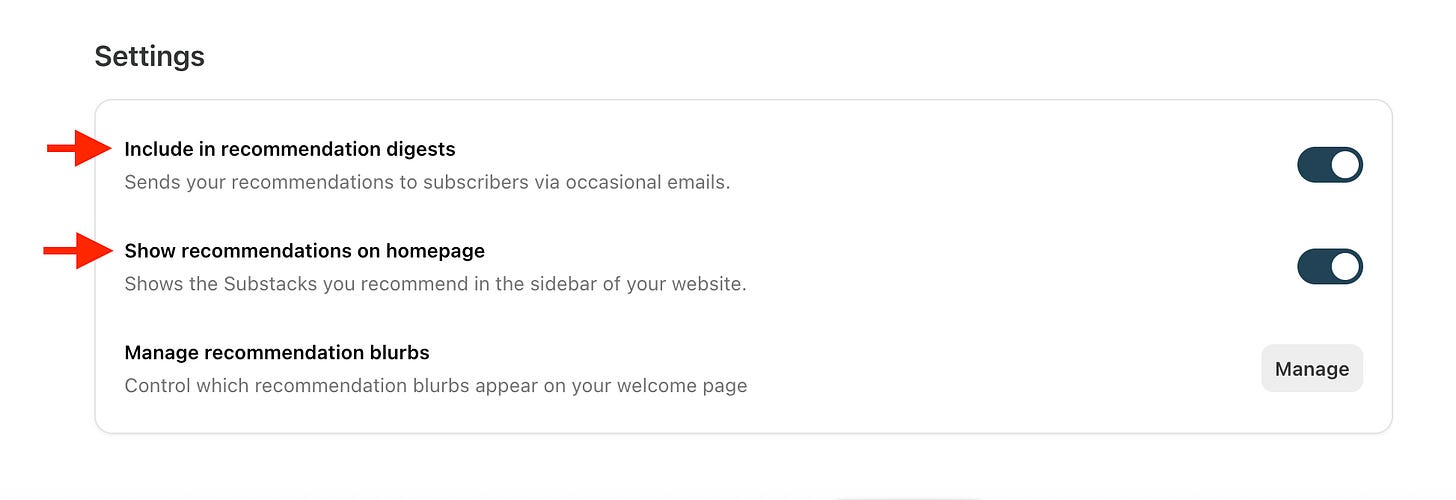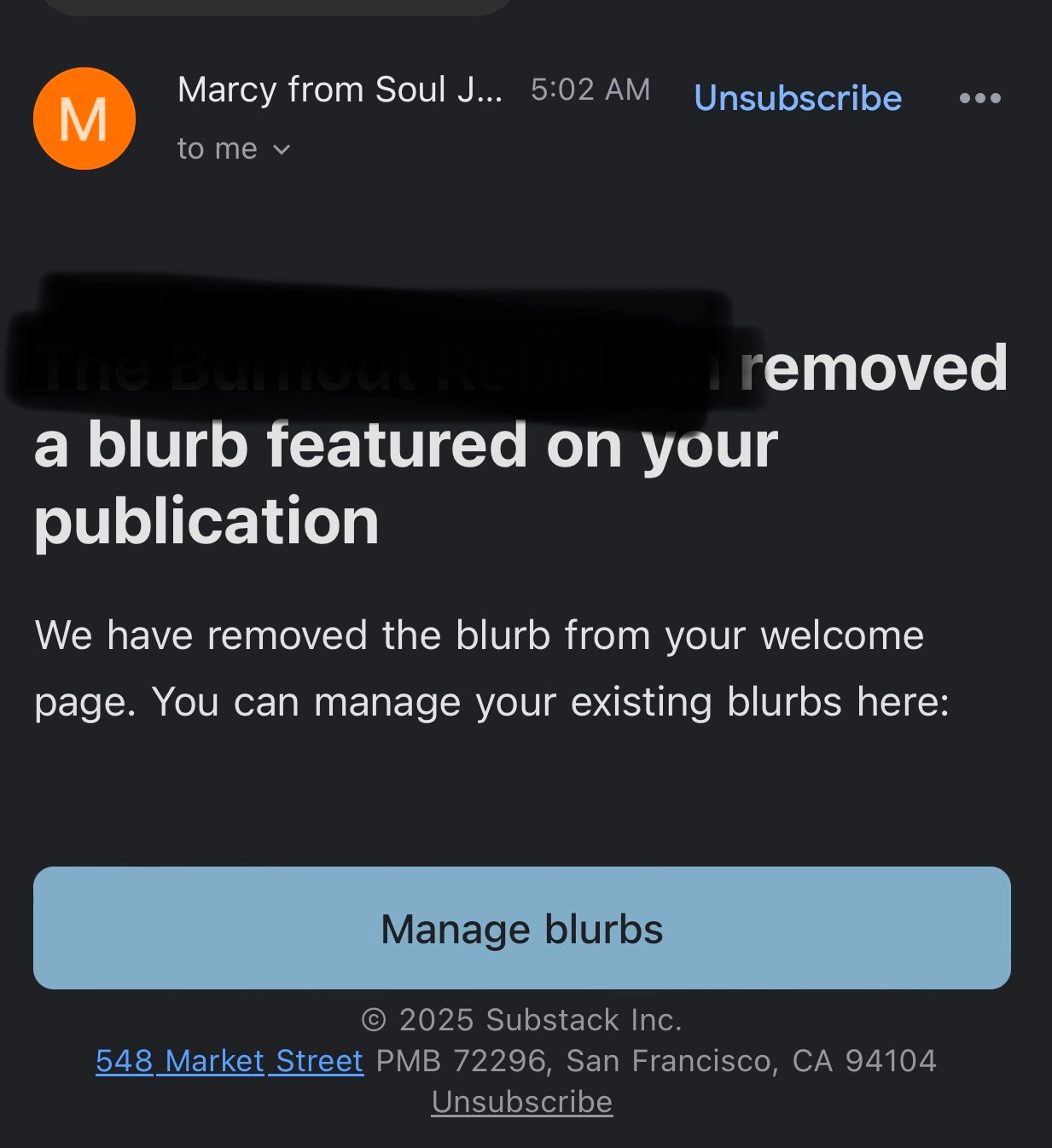This post is part of the Keys to Collaboration series, which gives you tips on how to collaborate and become a better collaborative partner.
Substack’s Recommendations feature is considered key to newsletter growth. As a result, many of us wonder if we have enough of them, how we can get more of them, and how many we should be giving out.
This has admittedly been a sticky topic for me. I intended to write this post a couple months ago, but I decided I wanted to give it some time, so I could gather more info and get clarity on where I stand on some of the more debated aspects of this feature.
In this post, I will:
Give an overview of the feature and some details you might not have known about
Talk about the challenges with Recommendation Swaps between writers
Explore the question of how many recommendations a writer “should” give
Offer some best practices we can follow as those who value meaningful collaboration
How Substack Recommendations Work
Substack’s Recommendations feature allows you to recommend other newsletters to your readers. These recommendations:
Pop up once someone subscribes to your newsletter
Appear on the homepage of your newsletter (if you want them to—see below)
Are emailed to your subscribers (if you want them to be—see below)
And here’s how these three features work:
For the pop-ups and homepage, Substack rotates the recommended publications for you, so the same ones aren’t always shown.
You can choose not to show your recommendations on your homepage. This feature is turned ON by default. See screenshot below.
Despite most people thinking the email feature cannot be turned off (including myself until recently), you can turn them off in the Settings section at the end of the Recommendations page. It’s labeled “Include in recommendation digests.” It is turned ON by default. See screenshot below.
Your subscribers are also able to unsubscribe from the recommendation digests while still remaining subscribed to your publication.
You can read more about all of this in an article from Substack here. And here is a screenshot of the settings:
With any recommendation, you can choose to simply recommend, or you can also write a nice blurb explaining why. The writer you are recommending can then choose to add your blurb to their publication’s Welcome page, so potential new subscribers can read them. These are always a nice touch. You can learn more about how to do that here, and if you look at the screenshot above, you’ll also see there’s a button in the Settings section for you to manage these blurbs on your publication.
Recommendation Swaps
If you’re new to Substack, getting these recommendations can take some time, which is why many are seeking partners for Recommendation Swaps. Essentially, this is when two people agree to recommend each other.
When people started requesting this as a form of collaboration on CollabStack, I was admittedly nervous. I could see the potential for this quickly leading to lots of artificial recommendations from people who don’t actually read each others newsletters, which goes against my mission to make this a space for meaningful collaboration.
I also heard stories of people reaching out to do a recommendation swap, then shortly after activating a recommendation, they deactivated it. This could be because some writers have decided to rotate their recommendations on a regular basis (more on this below), but they did not inform the other person that they agreed to do the swap with that they’d be doing that.
With all this said, I don’t think Recommendation Swaps are in and of themselves a bad thing. They are great if they are done in a genuine way that is mutually beneficial. (More on this when I outline some best practices below.)
Note: If you want to see which of your recommendations are active, visit the Recommendations tab and check the Status column—that will tell you whether a recommendation is active or inactive. You can learn more about this here.
How Many Publications to Recommend
A Substack expert/teacher recently suggested that you keep the number of publications you recommend to a minimum, as recommending too many newsletters doesn’t seem genuine.
At first I was irritated by this advice, but I think this likely speaks to what I was worried about—that people are doing swaps just for the sake of growth, hence having many that don’t really mean much. So this expert suggested that if you wanted to recommend more than a few publications, you should manually rotate them yourself each month, keeping only a few active and setting the rest to inactive.
Shortly after this expert recommended this, my biggest recommendation source on my main publication, Soul Journaling Sessions, decided to deactivate their recommendation. I got a notification saying that their very nice blurb (that I was so happy to receive when I first saw it) was removed from my Welcome page.
I know they likely did it because of this expert’s recommendation, so I tried not to take it personally, but it was nonetheless a disappointment. The impact of the loss was felt by a small publication like mine. And I know I’m not the only smaller creator this happened to.
While in theory people will rotate their recs, it does take extra work to do this manually. There’s a good chance people will forget or won’t end up circling back around to recommend someone they removed.
My Personal Philosophy with Recommendations
I am not a Substack expert, so I can’t speak to whether keeping the number of recommendations to a minimum helps you grow in any way. Perhaps it does make you more credible, but I honestly do not pay attention to how many newsletters another writer recommends. The number they have does not impact my decision to subscribe.
After talking to some other writers who are minimizing their recommendations, I understand that having too many recommendations on your list could be overwhelming. Some writers genuinely want their lists to be well-curated, and perhaps having fewer publications rotating through on the homepage could give those writers they do recommend more exposure.
I personally have different approaches for my two publications: one reaches far and wide and one is more curated. For my first publication, Soul Journaling Sessions, I recommend every writer I want to support, plus anyone who collaborates with me on that publication. On CollabStack, I keep my recommendations to publications that are focused on business, teach about Substack, or are highly collaborative. I currently do not have a set number of recommendations I’m aiming for.
I do not believe there is a magic number of recommendations you “should” have. What I do recommend (for lack of a better term!) is to stick to what you naturally would be inclined to do with your recommendations: If you want to recommend many newsletters that you love, go for it! If you want a small, well-curated list, go for it!
But I have one ask: Don’t change what you want to do based on anything I or any other writer/teacher/expert says. And don’t change your plans out of fear of what people might think. Your people will find you and stick around for many other reasons than the number of people you recommend.
And if you do for any reason decide to trim your list, I have a few thoughts on the kindest way to go about that below.
Best Practices for Recommendation Swaps
If you’re going to use CollabStack (or any other community supporting writers on Substack) to request Recommendation Swaps:
Be intentional. Have criteria and/or a process to help you decide who you’d like to swap with. Beyond your own criteria or guidelines that align with your personal values, I suggest:
Seeking people who say they are open to Recommendation Swaps. (Many people say this in their CollabStack profile, and if you forgot to, let me know by filling out the update form, and I will add it for you.)
Seeking people who write in the same categories, about the same topics, or about topics complimentary to yours.
Subscribing and reading 2-3 posts from them.
If you truly enjoy reading AND want to continue reading beyond those 2-3 posts, consider doing a swap.
Agree on whether you will write blurbs for each other or just do the standard recommendation with no blurb. This ensures the exchange is even, as sometimes a good blurb can take a bit of time to write!
Be upfront about how you plan to manage your list. If you intend to swap recommendations in and out, let the other person know from the start. Be clear about the timeframe in which you intend to make the changes. This way, they are not taken by surprise.
And if you’re writing them a blurb, this is even more important, as they may not want to put your blurb on their Welcome page, knowing it will be removed. Give them a copy of the text you write for the blurb so they have the opportunity to use it elsewhere if they wish.
Trim or Curate Your List Mindfully
If you’re going to trim your list, I have some tips to help you do this with kindness, so that others are not taken by surprise. This also shows goodwill and makes people more likely to continue to support you going forward.
Again, be intentional and have criteria for who you’d like to keep on your list or how you’d like to rotate. Do you want to keep mostly smaller creators on your list? Only those in similar categories to you? Only publications that you currently read regularly? There are many paths to consider, and none right or wrong.
If you’re going to remove any that you’ve written a blurb for, reach out to let that writer know. Give them a copy of the text of the blurb you’ve written so they could potentially use it elsewhere. You can find this on your Dashboard in the Recommendations section.
For any other recommendations that you deactivate, you can choose to give them a heads up if that feels okay to you, and/or you can find some other ways to support them. This could include liking posts, commenting on posts, restacking, etc. Recommendations are not the only way to support a writer.
Note: Of course, if you’re no longer recommending someone because your values don’t align, and you truly wish to no longer support them, simply deactivate that recommendation. This process is for those you do still want to support in some capacity.
One Last Note
Everything I’ve included here is simply what I recommend based on my experience and from talking with others. Please take what resonates and ditch the rest. Always choose what feels right to you!
Share Your Thoughts
How do you currently curate your list of recommendations? Have you had a good experience doing Recommendation Swaps, and if so, what tips do you have to share? Let us know in the comments!
Ready to Collaborate?
You can find potential collaborators over on the CollabStack Directory, or check in on our May Call for Collaboration, which is still open.
Thank you so much for checking out and supporting CollabStack!
If you love the whole idea of CollabStack, please consider becoming a free subscriber or a CollabStack Premium Member (paid subscriber). You can also sponsor a post.
Until next time, Happy Collaborating!
Hi, I’m Marcy Farrey (pronounced Fairy 🧚♀️ ), and I’m on a mission to help others connect and collaborate in meaningful ways here on Substack. Consider me your Farrey 🧚♀️ Godmother of Collaboration!
If you love CollabStack, it would mean so much to me if you restacked this post so more people can participate. This will help our little community grow. Thank you for your support!












Well done Marcy! This really outlines how to delete recommendations gracefully and with empathy. But I hold firm…that is a thing I will never do. Unless they start talking crazy all of a sudden, my recommendations are like my friendship…here for the long haul!
I have never been a huge fan of proscriptive methods for deciding who and in what way I support on Substack. I think I'm currently recommending 138 publications. The number is high by sheer fluke; I genuinely feel that each publication I recommend is worth reading. Sometimes I'll go the extra mile and write a blurb. I don't have any expectation of reciprocation. That expectation feels too transactional to me. If I recommend someone and they don't recommend me back, their writing resonated with me more than mine did with theirs. don't take it personally. I'm honored that I found their writing; the rest is a bonus. We all have unique tastes and I try to honor that in this creative space.